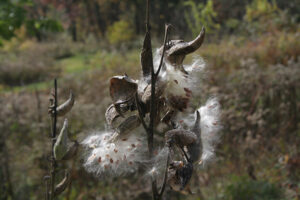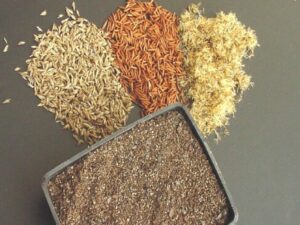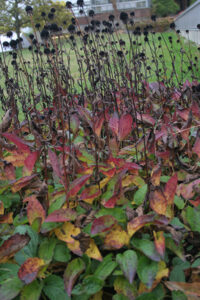By Leslie Duthie, New England Botanic Garden Volunteer
August 2024
When someone says ‘seeds’ a picture of brightly colored seed packets comes into most people’s mind. Vegetables, annual flowers, and seed mixes with blue, pink, and purple watercolor images representing meadow plants are what we often imagine. But ‘seeds’ can evoke other thoughts.
What about the image of a milkweed pod cracking open to free small, round, brown wafers carried on the wind by silky strands that almost look like parachutes? The seeds of clematis appear in the shrubs as curly, fuzzy tails sticking out in round clusters, suddenly visible when the leaves fall. Then there’s the bottlebrush spikes of tan blazing star seed or dark brown gum-drop seed heads of coneflowers? These are seeds too — seeds of our native species growing on roadsides or in our gardens.
Native plants are easy to grow from seeds found in our gardens, alongside the road, or on our walk at the local trail. The time to collect these seeds can be throughout the growing season, but most seeds are found and collected in the fall. With some knowledge, skill and care we can increase the number of native plants in our garden and experience the wonder of growing plants from seed.
A few things to keep in mind:
- Get permission. Do not collect from public gardens, botanic gardens, other people’s gardens without permission.
- Collect only a few. Plants need to replenish their populations from time to time. Only collect about 10% of the seed you see. This small amount is plenty for you and allows the plant population to remain. Don’t collect rare species, or if you see only one of a certain plant type in the area.
- Observe first, collect second. Make sure you know what you are collecting. Observe the plant in flower, check its identification, and know what you are looking at before collecting seed
- Plan for proper storage. Store the seed in a cool location not the glovebox of your car!
Collecting and sowing
Seed should be removed from their ‘container’ on the plant. Sometimes this is pretty easy — just opening the seed pod and allowing them to fall out. Sometimes keeping the seed dry in a paper bag helps to release the seed from its pod or capsule. In any case, you want to keep just the seed, not all the extra material that comes with it. Collect, clean, and label your seed so you know what you are growing.
Native plants of the northeast are relatively easy to grow from seed, you just need to mimic the conditions they are exposed to in nature. Our seeds expect a winter season, so this usually means it is best to sow our seed in the fall. You can create a ‘growing bed’ where you scatter your seed in a particular area to allow them to germinate and grow on their own. Or you can have more control by sowing them in a flat, a seed tray or a pot. This is a particularly good method when the seed are small.
In a bed, remove all the weeds and any extra plant material. Rake over the area with an iron rake to loosen up the surface soil. Scatter your seed, or plant them in rows, they do not have to be spaced out – you can select the best ones when they germinate. Cover the seed with some additional soil. Label the row or space. When you have finished sowing seed in the bed, and have them labeled, a light coating of leaves will help protect the seed bed through the winter months.
If using a flat, tray, or pot, use a bagged soil mix. Fill the container with the soil, water the soil into the container so it is thoroughly moist. Sprinkle the seed over the surface and cover with a light layer of soil mix or coarse sand. Trays or pots may need to be protected from birds, rodents, or other creatures by covering them with some hardware cloth (wire mesh) for the winter. Leave the containers outside.
Most of our native plants need 30 to 90 days of cold weather to help them break dormancy. Sowing the seed between October and December will allow you to give them a head start indoors in March if you have a good location to grow your seed on. It’s also fine to leave the seed containers outside where they will germinate naturally in spring.
Germination
Little seedlings popping out of the soil means success! Inseed beds, you want to be sure that plants have enough room to grow without competition so pull out the extras to give them more space. In containers, seedlings can be transplanted once they are big enough to handle. Gently pull seedlings apart and put the new ones into a new flat or container with some room to grow on. A little crowding is not bad, but it is nice to allow the plants room to grow and mature until they are large enough to go into the garden.
Most of your plants will be perennial, living for many years. Be patient with them! Some plants will grow quickly and bloom the first year, while others may take several years to reach maturity and flower. It is fine to plant small seedlings into garden beds, just be mindful that they will need a little extra care and attention the first year. After that, they should grow on without much assistance – just make sure you remember where they are!
The wonder of seeds
There are lots of nuances to growing plants — expect some failures, but revel in your successes! Try to start with larger seeded plants and be sure to observe your plants as they grow from newly germinated seedlings to maturity. It will help you recognize good seedlings in the garden. Some of our native plants will require two years to germinate while others do not need the cold winter in order to germinate. As you work with more plants and more seeds you will start to know what to do.
For resources, seed catalogs will sometimes give good germination information. Visit various websites for seed suppliers to get more insight on how to grow our native plants. There are also some good books on growing native plants. Check out the local bookstore and the internet for choices for your region.
It’s a joy to grow native plants from seed, so be bold and experiment! Sometimes we learn more from our failures than from our successes. There is lots of advice out there, but we all must find what works best for us.
About the Author
Leslie Duthie worked as a horticulturist growing, planting, and caring for native plants for over 40 years. Now retired, she enjoys all kinds of gardening. Volunteering at NEBG, Leslie cares for its historic apple orchard. She also serves as a board member of the Ecological Landscape Alliance, an organization educating people about ecological gardening practices.



